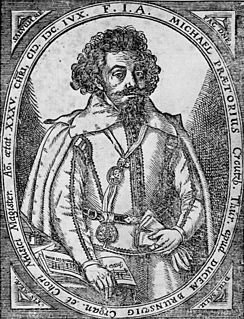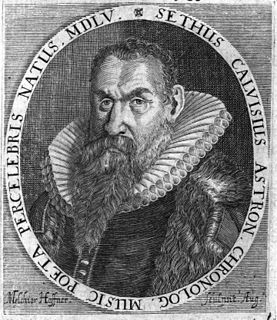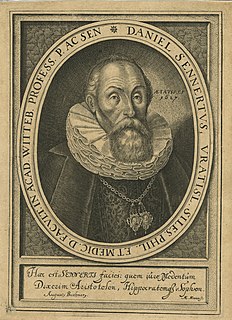Eucharius Hoffmann (born Heldburg; died Stralsund, 10 May 1588) was a German composer and music theorist, Hoffmann was Kantor at Stralsund from 1566 until 1580. [1] [2]
Eucharius Hoffmann (born Heldburg; died Stralsund, 10 May 1588) was a German composer and music theorist, Hoffmann was Kantor at Stralsund from 1566 until 1580. [1] [2]
Collections:
Heinrich Faber was a German music theorist, composer, and Kantor.

Michael Praetorius was a German composer, organist, and music theorist. He was one of the most versatile composers of his age, being particularly significant in the development of musical forms based on Protestant hymns, many of which reflect an effort to improve the relationship between Protestants and Catholics.
The Modistae, also known as the speculative grammarians, were the members of a school of grammarian philosophy known as Modism or speculative grammar, active in northern France, Germany, England, and Denmark in the 13th and 14th centuries. Their influence was felt much less in the southern part of Europe, where the somewhat opposing tradition of the so-called "pedagogical grammar" never lost its preponderance.
The Hypophrygian mode, literally meaning "below Phrygian ", is a musical mode or diatonic scale in medieval chant theory, the fourth mode of church music. This mode is the plagal counterpart of the authentic third mode, which was called Phrygian. In the Middle Ages and Renaissance this mode was described in two ways: the diatonic scale from B to B an octave above, divided at the mode final E ; and as a mode with final E and ambitus from the A below to the C above. The note A above the final had an important melodic function. The melodic range of the ecclesiastical Hypophrygian mode therefore goes from the perfect fourth or fifth below the tonic to the perfect fifth or minor sixth above.

Johann Kuhnau was a German polymath: known primarily as composer today, he was also active as novelist, translator, lawyer, and music theorist, being able late in life to combine these activities with the duties of his official post of Thomaskantor in Leipzig, which he occupied for 21 years. Much of his music, including operas, masses, and other large-scale vocal works, is lost. His reputation today rests on a set of programmatic keyboard sonatas published in 1700, in which each sonata depicted in detail a particular story from the Bible. After his death, Kuhnau was succeeded as Thomaskantor by Johann Sebastian Bach.
Johannes de Muris, or John of Murs, was a French philosopher, astronomer, mathematician, and music theorist best known for treatises on the ars nova, titled Ars nove musice.

Sethus Calvisius or Setho Calvisio, originally Seth Kalwitz, was a German music theorist, composer, chronologer, astronomer, and teacher of the late Renaissance.
Juan Bautista Comes, aka per Valencian spelling Joan Baptista Comes, was a Spanish Baroque composer who was born and died in Valencia.
Conrad Dasypodius was a professor of mathematics in Strasbourg, Alsace. He was born in Frauenfeld, Thurgau, Switzerland. His first name was also rendered as Konrad or Conradus or Cunradus, and his last name has been alternatively stated as Rauchfuss, Rauchfuß, and Hasenfratz. He was the son of Petrus Dasypodius, a humanist and lexicographer.
Alypius of Alexandria was a Greek writer on music who flourished around 360. Of his works, only a small fragment has been preserved, under the title of Introduction to Music.

Daniel Sennert was a renowned German physician and a prolific academic writer, especially in the field of alchemy or chemistry. He held the position of professor of medicine at the University of Wittenberg for many years.
Marko Ivan Lukačić was a Croatian-born musician and composer of the Renaissance and early Baroque.
Pedro Ocharte was one of the first printers in the Americas, active from 1563 to 1592.
Gallus Dressler was a German composer and music theorist who served as Kantor in the church school at Magdeburg. Though a few of his works have remained in the choral repertoire, he is best known for his theoretical writings, especially his Praecepta musicae poeticae, which contains some of the earliest detailed description of the compositional process of the Renaissance motet.
Johann Vierdanck was a German violinist, cornettist, and composer of the Baroque period.
Daniel Friderici was a German cantor, conductor, and composer.

Syntagma Musicum is a book by the German musicologist Michael Praetorius, published in Wittenberg and Wolfenbüttel in three parts between 1614 and 1620. It is one of the most commonly used research sources for the music theory of the seventeenth century. The second work De Organographia illustrates and describes musical instruments and their use; becoming a valuable resource for the research and reconstruction of early instruments.
Paolo Isnardi was a late-Renaissance choirmaster and composer.

Jacob Bathen or Jacob Baethen, latinised as Jacobus Bathius, Iacobus Batius and Jacobus Bathenius, was a Flemish bookseller, printer and publisher of the 16th century, mainly known now for music publications. He is sometimes confused with Johannes Baethen, a printer active in Leuven and Cologne between 1552 and 1562, who was likely his brother. Jacob was active in Leuven, Maastricht and Düsseldorf. He is mainly remembered for his publication of the so-called Maastricht songbook of 1554, which is one of only five surviving song books in the Dutch language from the 16th century.
| This German musical biography article is a stub. You can help Wikipedia by expanding it. |